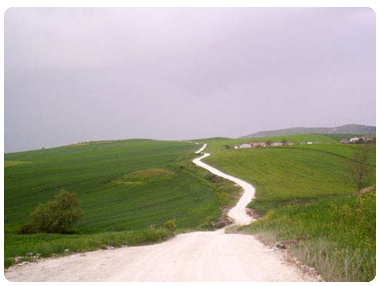 |
“Tratturo” is the
Italian word for the transhumance trail in ancient Samnium. Besides being
a real green grass road which allowed cattle of various kinds of animals
to be transferred from mountain pastures to valley meadows, and back, in
autumn and spring, it constituted first of all a sacred symbol binding in
a religious, cultural and political union the different tribes that traced
back their origins to the same Samnite ethnic group.
Their primitive economy had diversified itself in the course of time in
two complementary activities: cattle raising (mostly sheep) and
agriculture, so that the tribes embraced as their distinctive activity
either that of little farmers and peasants, on the one hand, or that of
cattle raisers and shepherds, on the other. Those separated pursuits
allowed their reciprocal survival in a barren mountainous territory, with
rare fertile plains. It was therefore livestock raising which constituted
the basic economic activity of Samnites.
The transhumance trails were green grass roads winding their way on well
drained soil which had been probably opened originally by the animals
themselves when man limited his activity for supplying his family with
food to hunting the free roaming cattle, in the Neolithic period. Later
on, different and successive civilizations took their residence and
developed within the territory (the Apennine civilization, Samnites,
Romans, etc.) and organized transhumance as their main economic activity.
And so it has been in the vast land of the Apennine range where Samnites
and their descendants lived, until the first half of last century.
Transhumance shepherds were helped in their hard work by big, white,
woolly sheepdogs, which had been crossbred since unknown times and are
still today employed in that trade: the ferocious Abruzzian sheepdog,
which isn’t afraid even of wolves.
All along the transhumance trails there were points of rest for animals
and men. But those cattle stations were also open markets where shepherds
could exchange wool, meat, cheese, lambs, etc. in return for cereals,
wine, olive oil, etc. On that occasion also another kind of exchange took
place: matrimonial alliances between families of peasants and shepherds.
Those stations were almost always within or in the immediate outskirts of
small villages (“oppida”, in Oscan) characterized by narrow, winding
streets, so that shepherds could easily control the sheep passage, by
abundant spring water and by inaccessible city walls called “mura
ciclopiche” (literally, cyclopean walls, a dry masonry made with massive
irregular stones).
The “oppida” and other minor rest places subdivided the transhumance
trails in stretches not longer than a day’s walking distance. In our
territory, important transhumance stations along the
“Pescasseroli-Candela” trail (the most relevant among the central and
southern trails of the Apennine whole net) were at Buonalbergo, Casalbore,
Malvizza (in Montecalvo Irpino territory) and at the ancient Samnite
federate township of Aequum Tuticum. (Sect.
n. )
|


